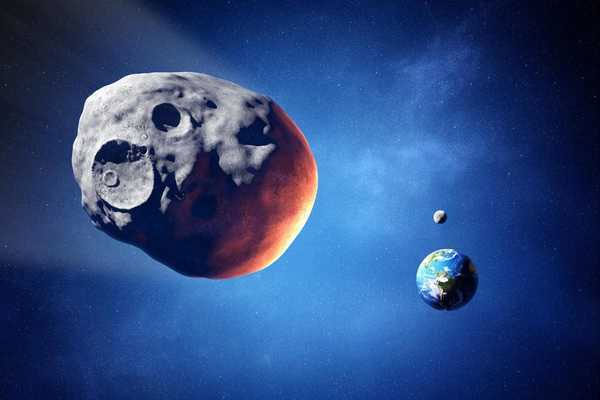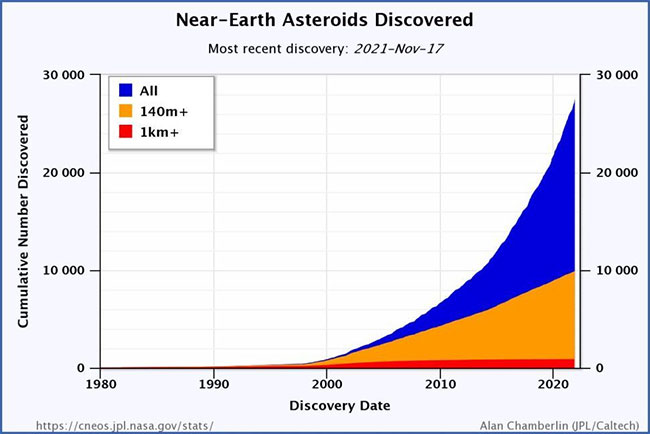We often hear about asteroids that could collide with Earth, but how many such asteroids actually pose a threat to our planet?
According to the National Aeronautics and Space Administration (NASA), there are currently no asteroids large enough that could collide with Earth and cause significant damage in the near future.
However, to date, astronomers have discovered over 27,000 near-Earth asteroids.
Kelly Fast, the Director of the Near-Earth Object Observation Program at NASA’s Planetary Defense Coordination Office, stated: “We are tracking the number of asteroids that could pose a threat to Earth, but at this time, there are no asteroids that we know of that could cause a significant threat to our planet.”

Currently, there are no asteroids large enough that could collide with Earth.
NASA has been conducting experiments to protect Earth from asteroid impacts, which will occur in two phases. The first phase, the Double Asteroid Redirection Test (DART), is set to launch at the end of this month. This mission is designed to test the second phase of the Earth protection process, which involves deflecting asteroids that threaten our planet.
However, before attempting to redirect an asteroid, scientists must first identify it and chart its orbit over the coming years to ascertain whether it will or could collide with Earth.
Nancy Chabot, a planetary scientist at the Johns Hopkins University Applied Physics Laboratory in Maryland and the DART Coordination Lead, believes: “People might think that protecting Earth is about deflecting asteroids, but that’s not the case. Tracking actual asteroids, identifying them, and finding them is really important to be able to do anything with them in the future.”

Recently discovered near-Earth asteroids
Scientists have identified approximately 750,000 asteroids to date, and there are millions of space rocks traversing the solar system. Fortunately, many of these are far from our planet.
Projects for Detecting Asteroids
Researchers have utilized both ground-based and space-based instruments to detect and catalog asteroids. Most of these discoveries have come since the late 1990s, although experts had previously warned about the threats posed by asteroids with little success.
A significant milestone was the collision of Comet Shoemaker-Levy 9 with Jupiter in 1994, which unexpectedly left Earth-sized scars in Jupiter’s clouds for months. This event led humanity to consider finding ways to detect near-Earth asteroids.
Subsequently, the U.S. Congress prioritized the search for asteroids, urging NASA to identify at least 90% of large and medium-sized asteroids. Today, numerous projects are underway to detect near-Earth asteroids, such as the Catalina Sky Survey based in Arizona, the Pan-STARRS observatory in Hawaii, the NEOWISE space telescope, and the ATLAS telescope.
Additionally, new projects will contribute to Earth protection missions, such as the Vera C. Rubin Observatory in Chile, which will begin observations in 2023, and a space-based mission named NEO Surveyor, which is being developed and expected to launch by the end of this decade.
The Formula for a “Potentially Hazardous Asteroid”
If all those observations detect an asteroid that exceeds a certain brightness and approaches within 7.48 million kilometers of Earth, that object will automatically be classified as a “potentially hazardous asteroid.”
However, for space researchers, unidentified asteroids are much scarier; these are asteroids that could suddenly come close to Earth without warning, too late for anyone to even attempt to change their trajectory.
Scientists believe they have found almost all of the largest asteroids, those larger than 1 kilometer. As of the end of 2020, scientists had only discovered 40% of near-Earth objects smaller than 1 kilometer.
While that number is impressive, NASA’s Planetary Defense Office estimates that at the current rate, scientists will need another 30 years to identify 90% of objects smaller than 1 kilometer, a goal that the U.S. Congress mandated NASA to achieve by 2020.
The mission to map as many asteroids as possible is why the number of “potentially hazardous asteroids” and near-Earth objects, in general, is significantly increasing.


















































